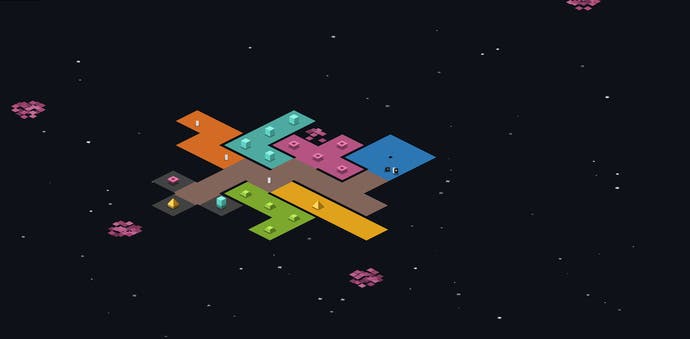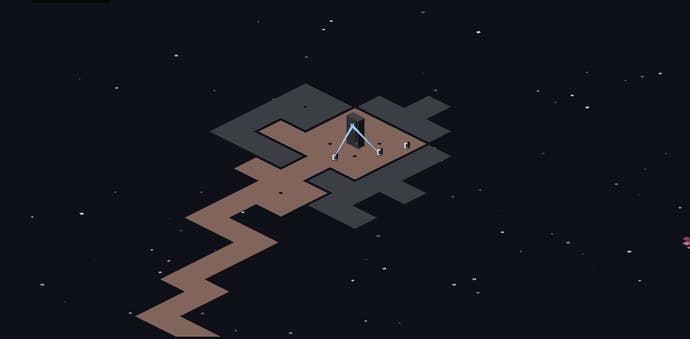Rymdkapsel preview: Addicted to base (building)
Prepare to lose lunch breaks to a new strain of "meditative strategy".
Rymdkapsel doesn't look much like Minecraft (in actuality, the only thing it really resembles is wall art for some big ticket New York restaurant) but it often feels like it all the same. Grapfrukt's latest is a strikingly colourful strategy game about building bases, gathering resources, and fighting off waves of enemies. It has the same cyclical shift between dreamy spells of pure construction and bursts of terrified defence that gives Notch's classic such a hectic thrill. It has the same constant struggle between the things you plan and the materials you have at your disposal, rendering every little victory so intensely - so intimately - satisfying.
The game's coming to iOS, Android and PlayStation Mobile early next year, and I've had a chance to play a preview build over the last few weeks. My demo consists of a single level, and, if you're obscenely talented at this whole Rymdkapsel business, you could probably have it finished off in thirty minutes or so. I've been playing it pretty much constantly since it arrived, however: this one short mission offers seemingly limitless outcomes, and provides a near-endless source of different things to go horribly, tragically, wonderfully awry.
The idea of the game is to construct a decent base for yourself, and the current mission tasks you with spreading out across the game's largely formless territory to reach three different monoliths. You may be guided by Kubrick, but you're also guided by utility: each monolith grants a perk that allows you to work more efficiently, adding another kink to the way that things can unfold.
The drag and drop interface makes bases easy to plan and construct. Rooms can only connect to corridors, meaning you can't just huddle your core systems together for safety, and everything you build comes with its own resource cost. Resources? Oh yes, you gather these - once your initial pool has run dry - by building specific rooms.

Resources are the heart of the fun - or the circulatory system of the fun at least. There are three to play with, and they each have their own quirks. Energy, which arrives in neat turquoise blocks, requires you to build reactors in order to harness the power of the sun. Particle fields, meanwhile, are floaty pink patches scattered around the map, and can be harvested by extractors to create little pills called material. Finally, tiny pyramids of food are created in kitchens, but they require sludge that's first cultivated in gardens. This sounds extra tricky, since you're managing two different rooms for a single resource, but in reality the extractors are the things that are going to get you into the most trouble early on: unlike other resource gatherers, the particle fields they rely on can run dry, leaving you unable to build any more rooms or corridors without selling existing structures back to the space bank at a loss. (This 'space bank' may not be a genuine part of the Rymdkapsel expanded universe, by the bye.) Once that's happened for the first time, you'll approach your next base very differently, shaping your constructions around the endless quest for diminishing particle fields, and taking bigger and bigger risks to keep the lights on. I'm sure there's a metaphor in here somewhere but I can't...quite...?
Actually, play for a while and you realise there's a fourth resource, and it comes with a pulse. Minions are your means of interacting with the world: you direct them around the map to construct rooms and corridors and to keep everything ticking along. Although they're just little white rectangles, it's a strangely emotive business to watch them scurrying back and forth, doing your bidding, and lying down for impromptu naps when idle. You create extra minions by adding quarters for them, and you control them all by shifting them from one task to another using an interface at the bottom of the screen. You can't move them directly: it makes your relationship with them all the more interesting, lending their tiny rectangular lives a sharpened sense of vulnerability in the vast, speckled darkness of space.
All of this sounds complex, perhaps, but colour-coded rooms and streamlined controls ensure the game's both easy to understand and coldly minimalist, allowing you to get a firm grasp of the simple stuff while the deeper complexities take hold. Complexities like building everything you need in order to keep building while you also work outwards towards those monoliths, for example. That's a stiff enough task on its own, and it's made truly torturous by the fact that the one thing you don't get any say over is the shape of the tiles you'll be building your rooms and corridors with. Rymdkapsel's blueprint pieces are shaped a bit like Tetronimos and, to a certain extent, they behave like them, too, with the top left corner of the screen showing you the next piece you'll be getting regardless of what you planned for it - or if it fits those plans.

This turns out to be be a stroke of design brilliance, leading to a constant tension between what you want to make and what you have to make it with. It's only heightened by the existing resource management game, too, and by the timer that sits at the bottom of the screen, constantly ticking down between attack waves - another elegant little twist to the formula that sees angry pink blobs descending to bust up your minions every few minutes, dividing your attention and forcing you to construct weapon rooms to tackle them.
There are lots of moving pieces, then, but the whole thing feels lean, compact, and self-contained. This is one of those games where defeat, even after an hour or two of work, leaves you with the sense that you're actually learning. I've made about a dozen bases by now, and each of them has been a little better, a little more functional than the last. There's a real pleasure to be had finding the redundancy in the stuff you've built, in adding a short corridor to the map that means an entire over-engineered sector can be sold to build up resources. There's a lovely sense of relief when you see off attackers without sacrificing a single minion, and there are moments of genuine elation when you manage to do two things at once - building a corridor linking to a new monolith, say, while simultaneously positioning yourself brilliantly to begin tapping a new particle field.
It's game design as engineering, but it's also game design as alchemy, I think, taking tower defence, god games, and even arcade oddities like Rampart - I bloody love Rampart - and transforming them into something unique. It'll be interesting to see how this clever congregation of systems expands into a finished product but, given all the construction I've been getting up to with such a tiny demo, I'm not particularly worried about how Rymdkapsel's going to, y'know, build on its early promise.

